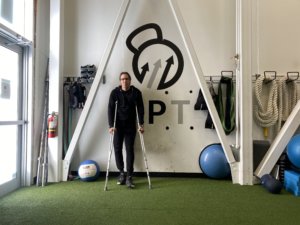Post 12 – Lessons Learned from My Rehab
Make Your Rehab Your Prehab
 I didn’t follow my own advice!
I didn’t follow my own advice!
I always tell athletes that if you have been injured you have to “make your rehab your prehab”.
Often, when an athlete gets injured, if they are even disciplined enough to do the rehab program, they often completely drop every rehab exercise once they are cleared to return to play.
But this is a big mistake, as injuries can creep back without an adequate maintenance stimulus or prehab.
Prehab or preventative rehab is the use of exercise in a proactive manner to reduce risk of (re)injury.
I’ve been fortunate enough to follow my advice for my lower back – I experienced multiple years of mobility issues in my late 20s and early 30s that kept me far away from the court and even normal function. After getting on a proper progressive rehab program I successfully rehabbed to the point I was able to play competitive basketball and even dunk well into my 40s! A lot of this was due to my almost daily regimen of prehab – carrying forward key exercises from my rehab into my daily routine and pre-workout warm ups.
But this time I didn’t follow my own advice! In early January 2022 I experienced a minor calf strain. I got some rehab, felt a bit better and pretty much went back on as normal. Just over two weeks later I partially tore my calf while playing 1 on 1 with a friend. I was lucky I didn’t fully tear it or tear my Achilles. But I was so mad…I knew I could have prevented this by continuing my rehab after I started feeling better!
Top 6 Lessons Learned from My Rehab
I’m now 12 weeks out, and almost done rehab. It’s going well. My rehab is looking more and more like a full workout at this point. I wish I didn’t get injured, but I’ve learned a lot through the process and I’m enjoying getting myself right again. I meant to share my progress live along with lessons learned but I got way behind in posts so I’ll share them all now. Here’s the top 6 lessons I learned/re-confirmed from my rehab process (shoutout to @teamaethos for the thoughtful rehab program and care)
- The cure for most injuries is NOT just rest/ice. If you find that’s the only rehab that’s prescribed to you then please go seek a second opinion from a qualified medical practitioner. Definitely in the early stages rest/ice may be the right approach but there will come a time that you need to get that tissue back to proper function and the only way is through rehab exercises.
- Make your rehab your prehab: Once you start getting better don’t just drop the rehab. Use those exercises from your rehab as PREHAB – use them in your warmup and your daily routine as a proactive measure to reduce the likelihood of (re)-injury.
- Rehab IS Exercise: Rehab involves the use of carefully selected, often low-level exercises with very thoughtful and gradual progressions over time.
- What gets measured gets improved: At PPT, we are always tracking everything – reps, weights, jump height, etc. That way we know where to start each session, and we have a baseline to measure improvement against. We also use it to ensure we get max intent out of our reps. It’s necessary to measure in rehab as well – to ensure you are not increasing the load, etc. by too much, and also to stay BELOW max intent – example normally I use the jump mat to measure how high I jump to ensure I get a max effort jump, but during rehab I used the jump mat to ensure I stay BELOW a certain percentage of max effort to avoid re-injury!
- Good strength training really is good injury prevention training.
- Related to the above, your rehab and your training should at some point include:
- Isolated exercises: rehab starts with isolation exercises and progresses to integrated exercises. Good functional training primarily focuses on integrated exercises, but isolated exercises should be included as part of your prehab.
- All contraction types: training often focuses on concentric contractions, but isometrics are key to rehab, and eccentrics are key to injury prevention.
- Joint By Joint Theory: Don’t just focus on the ‘injured’ joint – much of injury prevention and rehab is about improving the joints above/below the injured joint.
- Gradual Progressions: Don’t rush it, but don’t stay at the same level for ever – your body will adapt and you will stop rehabbing/making gains. Gradually progress – the level of difficulty of the exercise, the load, etc. over time for constant improvement!
